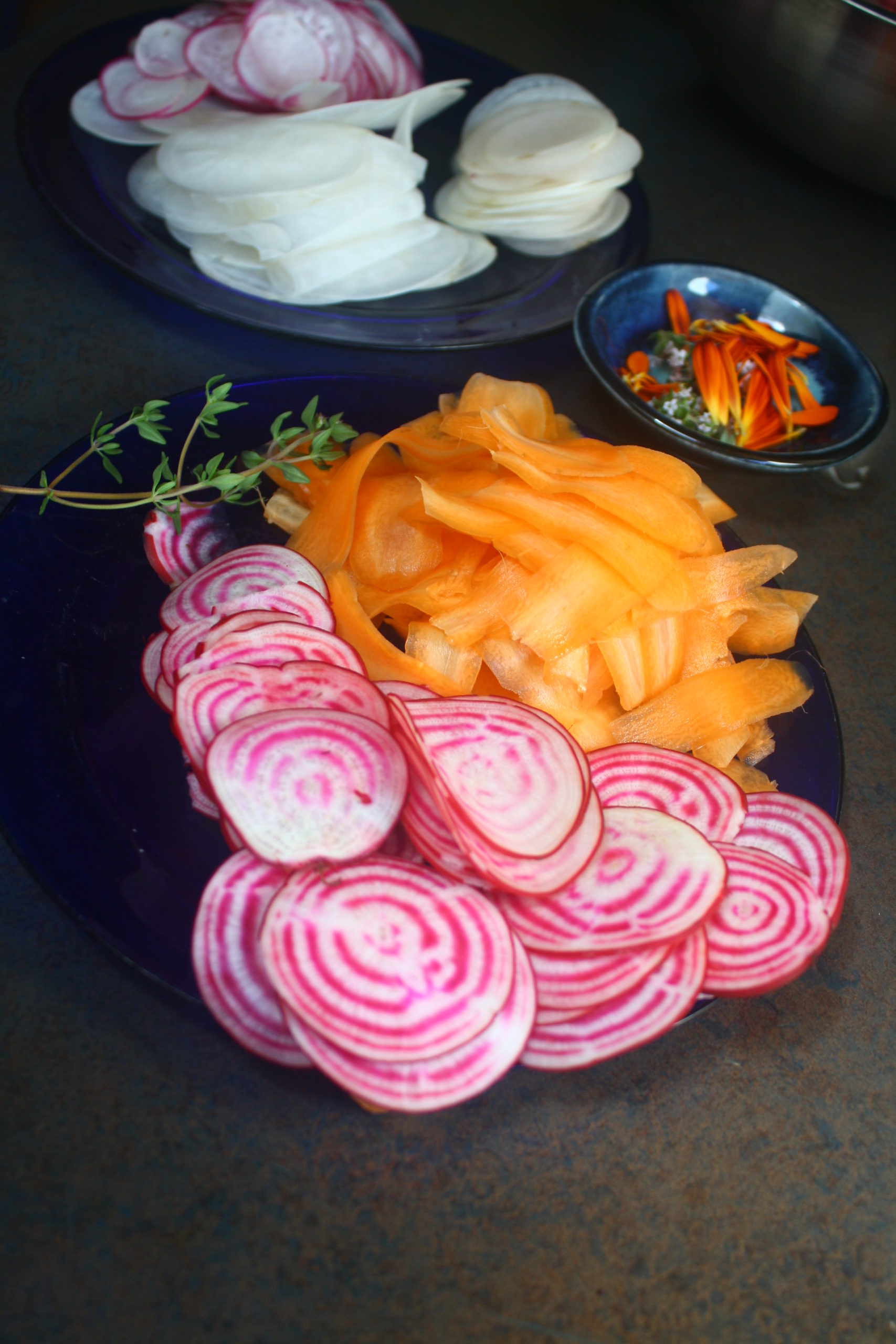By Dana Zia, The Golightly Gourmet
The turnip is one of the veggies that I could never remember what it looked like. I knew it was white and that was about it. Then the CSA box of veggies that I get weekly made sure that I learned all about turnips because I always had them. After I used up all the produce from the box each week, there was always a bag full of these large white orbs bouncing around in my produce drawer demanding I figure them out.
Now I know more about turnips and I really have discovered that I enjoy them. In case you haven’t been in the CSA turnip immersion program, turnips are round white root veggies that are in the noble Brassica family along with the likes of kale, broccoli, mustard and cabbage. There are many varieties, as you can imagine, but the two simplest categories are spring and fall turnips.
The fall variety is the classic cream colored turnip with thick skin, hearty flesh and light purple shading on the top and bottom. They are excellent for roasting, scalloping, mashing and soups. The spring varieties, also called salad turnips, are usually all white, thin skinned and have a delicate flesh that is excellent for salads, pickling and eating raw. They are also good stir fried and lightly roasted.
It was interesting to ask around and find out that not many people are into turnips. These vegetables have been domesticated for a very long time and started as a crop in India in the 15 century BC. The Romans were fond of them and spread them liberally across Europe where they are still popular today for both human and livestock consumption. So why do they have such a bad rap?
Well, come to find out they contain a bitter compound in them that releases a small amount of cyanide. It isn’t enough to hurt you on any level but certain folks can detect it if they have inherited two copies of the “sensitive” gene that dates back to the Neanderthal. This ancient gene was to keep the caveman from eating poisonous food (due to their wee brain) and people possessing a pair of them will find the root bitter and unpalatable. This has given the turnip its unfair and undesirable reputation.
If you haven’t given this root a try I recommend starting right now with the sweet spring salad turnips called Hakurei” or “Tokyo” turnips that are available now. When using them think “radishes” because they are very much like that spunky root but without the kick. Grate them into salads and serve them raw with a touch of salt on veggie platters. They are also excellent tossed in olive oil, salt and pepper and roasted in a hot oven, 400 degrees, till golden turning once, about 15 minutes.
Farmer Ginger of Revolution Gardens recommends lightly sautéing them with sugar snaps peas with grated ginger and organic soy sauce. She also recommends using them as a refreshing crunch like in tacos and sandwiches. Here is a fun salad recipe that highlights much of our beautiful local produce that will be tempting us at the farmers markets throughout Tillamook County in Manzanita, Tillamook and Pacific City opening the weekend of June 10th, or at Neskowin’s Farmers Market which is now open on Saturdays. You can use raw beets for this recipe if you like but I like to cook my beets by boiling them till just tender and use them in salads. They are easier on the digestion that way. Hopefully I have inspired you to give an old vegetable a chance…or a second chance.

Shaved spring root salad with citrus dressing
This dressing calls for hazelnut oil which adds a wonderful flavor to anything it is added to. I recommend you get some if you have never played with it. It is amazing added to baked goods! If you do not have it, olive oil can be subbed for it. Serves four.
The citrus dressing
2 TBLS of hazelnuts
1/4 cup of fresh orange juice
1 TBLS of fresh lemon juice
2 TBLS of olive oil
1 TBLS of hazelnut oil (Can replace this with olive oil)
1 tsp of warmed honey
1 TBLS of a fresh herb (I used thyme)
Sea salt and pepper to taste
The salad
2 medium red beets or different colors, boiled till just tender
1 medium salad turnip
4-5 small carrots
2-3 radishes
Spring greens to layer the shaved roots on
2 stocks of spring green onions, sliced thin
2 TBLS of hazelnuts roughly chopped
Feta cheese
Fresh herbs and flower petals for garnish (optional)
Salad time! Start by making the salad dressing by adding all the dressing ingredients to a blender and giving it a whirl till well blended. Season with salt and pepper to taste then set aside in the fridge till ready to use.

